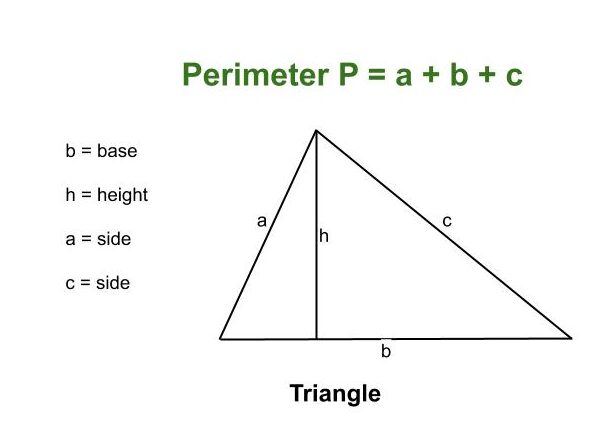Before answering your question, let me give you a brief introduction of what perimeter actually means.
In geometry, the perimeter is the length of the outer line of a shape. Perimeter is defined as the uninterrupted continuous line that makes the boundary of a closed geometrical figure. The term ‘perimeter’ originates from the Greek word ‘peri’ meaning around and ‘metron’ meaning measure.
The perimeter of any two-dimensional shape is defined as the distance around that shape. If a shape is expanded into a linear form, then the length of that linear form will be the perimeter.
A triangle is one of the most common shapes in geometry. It is a closed two-dimensional figure. Triangles consist of three sides; hence, they are also a three-sided polygon. All sides are composed of straight lines. The point where two straight lines meet is known as the vertex and each vertex forms an angle. Thus, a triangle consists of three vertices as well as three angles. The sum of the interior angles of a triangle makes an angle of 180°. Among all the polygons, the triangle is a polygon with the least number of sides. So, a triangle can be defined as a three-sided two-dimensional geometrical figure whose interior angles are equal to 180°.
On the basis of the angles and side length, the triangles can be categorized into six types:
Based on the length of the sides – Scalene Triangle, Isosceles Triangle & Equilateral Triangle
Based on the angles – Acute Angle Triangle, Obtuse Angle Triangle & Right-Angle Triangle
A perimeter of a triangle is defined as the total length of the outline of the triangle. Since a triangle has three sides, therefore, the perimeter of any given triangle, irrespective of their types, is equal to the sum of all its three sides. The measurement unit of the perimeter is the same as the unit of sides of the triangle.
Perimeter = Sum of all three sides
For example, let us suppose ABC is a triangle; if AB, BC and AC are the lengths of its sides, then the perimeter of ABC will be:
Perimeter = AB+BC+AC
A Right triangle consists of a base(b), a perpendicular(p) and a hypotenuse (h) as its sides, From the Pythagoras theorem, we know that,
h2 = b2 + p2
Hence, the Perimeter of a right-angle triangle will be,
Perimeter = b + p + h
Area and perimeter are two crucial key concepts of mathematics. They build the foundation for advanced mathematics. Both area and perimeter are used to determine the physical space occupied by an object. The area is defined as the 2-dimensional space that is occupied or covered by a closed figure, whereas the perimeter is the distance of the boundary surrounding the closed figure. Both concepts have a practical use and are applied in our day-to-day life.
Area and perimeter are applicable in our everyday life. We know that the area is basically the space covered by a shape and perimeter is the distance around the shape. For example, the area can be used to calculate the size of the carpet required to cover the whole floor of a room. The perimeter, on the other hand, can be used to calculate the length of the fence that will be required to surround a garden. Two shapes may possess the same perimeter, but different areas or may possess the same area, but different perimeters. The area is measured in square units i.e., square kilometres, square feet, etc. While, measurement of the perimeter of a shape is done in linear units like kilometres, inches, feet, etc. Perimeter measures only one dimension, i.e., length of the object. Whereas, area measures two dimensions, i.e., length and width of the object.
Although the two mathematical concepts are different from each other, however, one can be used to calculate the other.
Here I will also suggest you to practice mathematics as much as possible. Try questions with different pattern. It will help you to understand the topic more clearly. You must understand that you can’t learn mathematics by just mugging up. You have to understand every step. Try to solve all the example question form the text book. It will help you to solve the problems from the exercise part.
Hope this helped you to clear your doubts.









